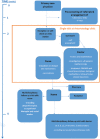Delivering a one-stop, integrated, and patient-centered service for patients with rheumatic diseases
- PMID: 27437101
- PMCID: PMC4941123
- DOI: 10.1177/2050312116654404
Delivering a one-stop, integrated, and patient-centered service for patients with rheumatic diseases
Abstract
Objective: To describe a one-stop, integrated rheumatology service and assess patient satisfaction.
Methods: A descriptive report and patient satisfaction survey of a rheumatology clinic model first developed in 1996 to enhance the patient "journey" through rheumatology services. A patient-satisfaction survey over a 3-week period assessed several aspects of care including quality of services, consultations, and patient education.
Results: All referrals are screened by a rheumatologist to pre-schedule laboratory/radiology/other tests for the visit. Upon arrival to the clinic, patients check-in at an electronic desk, and then complete the electronic GoTreatIT monitoring system which assesses patient-reported outcomes. The patient is reviewed by a doctor in a 30- to 60-min consultation, and then by a nurse (for diagnosis/treatment education, vaccinations). An ultrasound machine and capillaroscopy are available for use in the clinic. Patients can be scheduled on the same day to see a nutritionist, physiotherapist, or other heath professionals as necessary. An "early-rheumatoid arthritis treatment path" is available to ensure early, intensive treatment. A patient satisfaction survey revealed high rating of the overall service (90.6/100). None of the patients felt that they lacked education on their disease or medication. Only 6% of the respondents gave negative feedback, reasons including feeling overwhelmed with information or not being given a cause for their symptoms. The multi-disciplinary approach was highly valued and only 3% would rather see a doctor and nurse on separate days.
Conclusion: The specific clinic model provides an ideal setting for a one-stop service, avoiding unnecessary visits, collecting patient data, and enhancing the patient experience and journey through the system. Where possible, the specific clinic model could be used or adapted to build similar models in other rheumatology departments. The clinic model could also form the basis for services in other specialties dealing with chronic conditions.
Keywords: Clinic model; integrated service; patient satisfaction; rheumatology.
Conflict of interest statement
Figures
Similar articles
-
A questionnaire survey of patient experience with the Rheumatology Monitoring Clinic in Singapore.Int J Rheum Dis. 2012 Aug;15(4):390-8. doi: 10.1111/j.1756-185X.2012.01738.x. Epub 2012 Apr 29. Int J Rheum Dis. 2012. PMID: 22898219
-
A multi-centre study of interactional style in nurse specialist- and physician-led Rheumatology clinics in the UK.Int J Nurs Stud. 2016 Jul;59:41-50. doi: 10.1016/j.ijnurstu.2016.02.009. Epub 2016 Feb 20. Int J Nurs Stud. 2016. PMID: 27222449
-
Rheumatological medicine literacy among Middle Eastern populations.Int J Rheum Dis. 2009 Dec;12(4):336-42. doi: 10.1111/j.1756-185X.2009.01432.x. Int J Rheum Dis. 2009. PMID: 20374372
-
The measurement of patients' expectations for health care: a review and psychometric testing of a measure of patients' expectations.Health Technol Assess. 2012 Jul;16(30):i-xii, 1-509. doi: 10.3310/hta16300. Health Technol Assess. 2012. PMID: 22747798 Review.
-
[Improved early diagnostics of rheumatic diseases : Monocentric experiences with an open rheumatological specialist consultation].Z Rheumatol. 2018 Nov;77(9):844-849. doi: 10.1007/s00393-018-0540-4. Z Rheumatol. 2018. PMID: 30255411 Review. German.
Cited by
-
The choice of treatment and the motivations behind it impact clinical outcomes among patients with adequate control of their rheumatic disease: A real-life study.PLoS One. 2024 Dec 12;19(12):e0315478. doi: 10.1371/journal.pone.0315478. eCollection 2024. PLoS One. 2024. PMID: 39666735 Free PMC article.
-
Improving efficiency of a rheumatology outpatient clinic through classification of newly referred patients.Rheumatol Adv Pract. 2025 Apr 18;9(2):rkae155. doi: 10.1093/rap/rkae155. eCollection 2025. Rheumatol Adv Pract. 2025. PMID: 40256632 Free PMC article.
-
Patient characteristics and healthcare utilisation among Danish patients with chronic conditions: a nationwide cohort study in general practice and hospitals.BMC Health Serv Res. 2020 Oct 26;20(1):976. doi: 10.1186/s12913-020-05820-3. BMC Health Serv Res. 2020. PMID: 33106173 Free PMC article.
-
A cross-sectional study of vitamin D levels in a large cohort of patients with rheumatic diseases.Clin Rheumatol. 2018 Mar;37(3):803-810. doi: 10.1007/s10067-017-3870-8. Epub 2017 Nov 7. Clin Rheumatol. 2018. PMID: 29116541 Free PMC article.
-
Clinical Visit Frequencies in Rheumatology: A Systematic Literature Review.Arthritis Care Res (Hoboken). 2023 Oct;75(10):2054-2062. doi: 10.1002/acr.25106. Epub 2023 Mar 23. Arthritis Care Res (Hoboken). 2023. PMID: 36807719 Free PMC article.
References
-
- Allaart CF, Breedveld FC, Dijkmans BA. Treatment of recent-onset rheumatoid arthritis: lessons from the BeSt study. J Rheumatol Suppl 2007; 80: 25–33. - PubMed
-
- Grigor C, Capell H, Stirling A, et al. Effect of a treatment strategy of tight control for rheumatoid arthritis (the TICORA study): a single-blind randomised controlled trial. Lancet 2004; 364(9430): 263–269. - PubMed
-
- Sokka T, Mäkinen H, Puolakka K, et al. Remission as the treatment goal—the FIN-RACo trial. Clin Exp Rheumatol 2006; 24(6 Suppl. 43): S-74–S-76. - PubMed
-
- Kauppi MJ, Säilä H, Belt EA, et al. Beware of the biologicals—hospitals may die: the Rheumatism Foundation Hospital, Heinola, Finland (1951–2010). Clin Rheumatol 2012; 31(8): 1151–1154. - PubMed
LinkOut - more resources
Full Text Sources
Other Literature Sources



